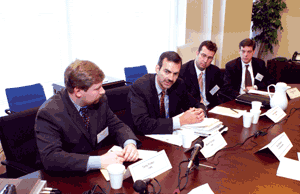The Office of Management and Budget's e-government team met recently at the Washington offices of GCN and Washington Technology to discuss the administration's e-gov progress.FORMAN: We took a two-pronged approach, and we continue to believe that's the right approach for e-government and the scorecard and for really transforming the federal government.One prong is to make the departments and agencies into e-government organizations or e-organizations. And within that, we look for things like whether they have a modernization blueprint or an enterprise architecture that really reflects a technology being used to modernize the organization, and how they're moving from a paperwork world to the e-world, like the rest of society has moved.We've got the use of capital planning business cases. I continue to be impressed with agencies' use of business cases'their growth. We're starting to get some accolades for being leaders in the use of capital planning.We also have, as a second prong, getting agencies involved in cross-agency e-government initiatives. And there, to get to green status, you have to be actively involved in three out of the four portfolios; meaning that you're partnering with other agencies that essentially touch the same group of citizens that you affect or you interface with.[IMGCAP(2)]On the results that we released for the midsession review, basically, I was very happy. There were 16 greens on how well agencies are making progress.So, are they making progress in putting together modernization blueprints? Are they making progress on their plans of action and milestones for the security plans? Are they making progress in a modernization blueprint that then ties back to their IT investment, their business cases?The business cases are giving us greater detail on how they're doing the modernization that they laid out in their blueprints, their enterprise architectures.For 16 of them, we are very happy that they are on track. They're making progress even though some of them are reds and yellows in status. The agencies that were yellow largely are making progress on their plans, but there are some issues that popped up.Maybe they were making progress on their architecture and business cases, but there are three or four major business cases that are still outstanding.And as you may recall, there was a group of roughly 400 projects that were put on the high-risk list. So, we've been working with the agencies to get those cleared, to fix those business cases and get those validated.There were, I think, very few reds in terms of progress on the scorecard. For the agencies that were reds in some areas, we've been making it clear that we see the scorecard and, indeed, the five items of the President's Management Agenda as being interrelated.We're also looking at financial management problems. Are agencies fixing that in their financial management systems investments? Is it showing up in the business architecture, in the enterprise architecture?And we're also tracking how well we're doing in our portfolios. That shows up, obviously, varied within the agencies' scores, but I think it's important to look at some of the things that are happening.Some of the projects are rolling out. If you take a look at the period of May through September, it's roughly 20 initial rollouts.So, on these cross-agency e-government initiatives, we have adopted a three-milestone or three-iteration approach. There's always at least one near-term milestone. That's deployment of a Web application. It's a low-hanging fruit. It gets some success for the team. So, we have a lot of these first-iteration, low-hanging fruits that are deploying, building success for the e-government initiatives, showing agencies they can work as teams across traditional silos.FRATER: We've started working on the government-to-government projects, and our partners have been pretty excited about what we've picked'especially the National Association of State CIOs and some of the folks like that. And so far, they have been more than willing to work with us. So I think that's been one of the bright spots.And in terms of where we need to do more work, I guess, in a perfect world, we could have yet further involvement from the local governments. It's easier for us to reach out to state governments just because they're so active and they come to town a lot. And since local governments are the major customer group, I feel like we can't get enough of their input into developing business cases and really understanding use requirements.FRATER: Starting with disaster management, we've recently had a pretty successful governmentwide meeting, led by Federal Emergency Management Agency CIO Ron Miller, that brought out probably the best representation we've had so far from state and local government.I think they're doing quite well. What's interesting from the user perspective is that it's not so much a redundancy issue, which we see clearly with geospatial and the E-Grants efforts. Those are more of a process integration, where no one's going to challenge the National Weather Service as being a leader in providing that type of information or the Transportation Department with transportation geographic information system layers.The Project Safecom initiative is also a very high-level initiative. It's very clearly important to homeland security. That's the one I was at first probably the most overwhelmed with because I don't have a background in radio technologies. I did have a few telecom courses, so I generally knew what they were talking about.There are science rules, there are technology rules, and then there are business rules. I mean, you don't want 100 percent interoperability all the time. Sometimes it's not appropriate. And so, you have all of those factors. And then you mix in the fact that they have massive investments'I mean, local-community concepts, huge investments.Finally, E-Grants is really doing great. The people who work on that issue are committed to serving their customers, serving their constituents. And they see this as something that's really going to help their customers.[IMGCAP(3)]ANDERSON: I'm pretty pleased with the progress. They all started out at different places. So it's kind of disingenuous to compare them side-by-side-by-side, but we'll go down each.The Online Rule-making initiative really is probably the most interesting or the one I'm probably most excited about because it's not only an e-government initiative, but it's also really an e-democracy component as well.We have a working prototype. It's not available to the public or businesses yet. We hope to roll that out by the end of August. And what it will be is an informational portal for citizens and businesses to be able to find out where rules and regulations are, and comment online.For those agencies that can't or don't take comments online at that point, it will at least provide users with the information that they need to submit written comments.Business Compliance One-Stop is also a great project. We'll have three states working with us on this project in the first phase: Georgia, Illinois and Washington. We're looking to roll out a prototype in early fall that will show three different layers of transactions at the federal, state and local levels. ANDERSON: Yes. The first two industry sectors we're going to focus on are restaurants and trucking. Restaurants in the state of Washington, and trucking in the state of Illinois.As to the federal asset sales project, we've already met an early milestone about rehosting a project for the FirstGov portal, but we will have a site by December that will be a one-stop tool for citizens and businesses to search across agencies and have at least an active online auction for personal property.Let's see. For international trade process streamlining, we're really focusing on the export side of the trade equation right now'making it easier for businesses, particularly small or medium enterprises, to export their products. We'll do that through an improvement in reaching across some agency silos to get that type of agency information available on the single site as opposed to having a small business really have to figure out or hire somebody to get the government information they need.ANDERSON: There will be some forms. And right now, what we're taking a look at is some of the forms that are most burdensome to businesses.On the tax project, expanding electronic-tax projects for businesses, too, is something that I think the business community has been talking about for a long time. They're finally going to be on the cusp of actually getting some benefit from this.ANDERSON: Downstream, it would be filing the forms.ANDERSON: The Commerce Department.ANDERSON: We'd like to see the import side involved in that project definitely because trade is obviously a two-way street. But, as Mark said, we're really focusing more on the low-hanging fruit early on, which is clearly the export and export promotion side of the equation.We're going to need to work with Customs to get that done. But in the short term, it's really working with Commerce and other agencies on export financing and providing companies with the information they need to make exporting easier.FORMAN: But most of these issues are going to get hashed out in the actual Extensible Markup Language data definitions because you wouldn't want separate sets of export and import data definitions. So it's at that XML layer that you'll see the most engagement between the outbound and the inbound.FORMAN: Right. And when it gets into the filing of reports, we haven't gotten anywhere near that yet. It's still paper. Rather than having electronic filing of paper forms, it's clear we've got to move to electronic transactions. And at that point, once you set up that XML definition, it's relatively straightforward.[IMGCAP(4)]WOMER: GovBenefits is the first one with a major public milestone, and that happened in the end of April. It's basically an eligibility tool for federal benefit programs. It went online. And we're basically, right now, in the stages of adding extra programs.As Mark pointed out, we added 30 not too long ago. And basically, until the end of the year, we're going to be adding a lot more. There's probably around 250 or so benefit programs that we have going on. With the 85 we have in there, there are a few programs that provide a lot of money.After that, the application process will be looked at and integrated. It probably won't be possible, especially at first, for all of them but for a few big ones. We'd like to see if we can pull that off.And all of these processes, of course, are going to require substantial interaction with state and local governments to make it realistic and to make it happen in an efficient and effective manner.Recreation One-Stop is a project basically to put federal recreation information online, and it had been ongoing before this point. We've just sort of accelerated it and added some new features.The public was invited to talk to basically private-sector groups interested in recreation about how they could work with the Interior Department, which is a large organizer of this project.That dialogue is ongoing. And we hope by the fall to come up with some good ideas. But in the meantime, we would like to add some functionality to the site, including some mapping pieces and grouping some of the information.But one piece that I totally didn't count on is that these outdoor agencies get a lot of volunteers. Volunteerism is a big part of maintaining the National Park Service. Interior has built a component on volunteerism to be able to post volunteer opportunities. And we hope to be able to put that out soon.WOMER: Yes. It's in prototype right now.FORMAN: And there's one thing that's unique about that. Having a method for collecting people who want to volunteer and route them to different agencies, that's pretty easy stuff. That's e-mail-type stuff.This tool, though, integrates a work-planning side. So this is not just for people to volunteer, it's for people who use volunteer labor within the government. And as Jonathan said, that's the recreation facilities and it's the veterans' hospitals. Everybody who's been in a hospital remembers the Candy Stripers or whatever. I did that when I was in college for a couple of summers.And so another aspect of that, obviously, is that we're focused on the human capital issue. And I think you can't forget that a major issue in managing parks comes down to getting the right volunteers to the right places. It's the first time anybody's created a workload-planning tool associated with that.WORMER: One of the other projects is the EZ Tax Filing Project.FORMAN: A big part of e-government is to simplify'leverage Web-type techniques and Web-type business approaches to make things simpler.The tax software industry has been dealing with this in the states. And they've basically taken the position that this is a cottage industry; it's been created because the tax code is so complicated. It's their job to uncomplicate it, not the IRS' job. And that's a basic philosophical difference.We believe that part of e-government is to reduce the requirement for lawyers and accountants. Uncomplicating government is a key value proposition for e-government. And that's threatening to certain groups.So basic things, to us, are no-brainers. I mean, it takes you 20 minutes to key in your data on a telephone. You can probably do that in a minute or less at a keyboard, right? And that's a simplification-type thing that we're talking about.One of the things that we made clear with EZ Tax Filing is that the IRS doesn't do its own software for new projects anymore. That's all by the Prime integrator. That's why they have the contractors. And so in no case would we have a bunch of guys from the IRS start building software again. That's not the intent here. Industry is going to do this, one way or the other.[Editor's note: Subsequent to this roundtable, the Bush administration and an association representing the tax software industry announced an agreement letting the IRS offer free online filing to an estimated 87 million taxpayers in exchange for the agency not developing its own software for that purpose.]WOMER: There are a couple more. There's USA Services, which is sort of a customer relationship management integration. This one is doing a real process integration, as well as information integration. And it should allow, basically, a little bit more integration of CRM efforts within the federal government.The hope is, sometime early this fall, to have some centralized CRM work. So, if someone doesn't know where to go, they get more help in being directed where to go in the federal government; not just via the Web, but also via phone and e-mail services.Finally, E-Loans is a project to simplify the loan processes of the federal government for the public. The interesting thing is that this has private-public partnership issues. About 88 percent of the monies that are loans from the federal government are really private- sector-based, and the federal government just guarantees the loans. Only about 12 percent are direct.It has information integration aspects in showing citizens where to find information. And it has process integration pieces.FORMAN: Do you want me to talk about internal efficiency and effectiveness? That is the heart of where we see some of the integration across the management agenda items because that gets to the management systems associated with financial management and human capital and performance-based budgeting.If you take a look at the projects related to human capital'E-Training, E-Recruitment, Enterprise Human Resources Integration, payroll processing, E-Clearance'some of what we've done, we've achieved just because we created a White House focus.On E-Clearance, for instance, basically everybody had their own database, and nobody trusted anyone in adjudicating background investigations. So, when an employee left government and came back or moved from one agency to another, we pretty much started at ground zero, re-adjudicated the file, and that created a huge backlog.And, the more times you've been investigated and proven to be cleared, the longer it takes them to clear you. It's the opposite of what you would expect. But that was simply a question of getting the key players together and getting them all to agree on some standards and to consolidate the database for adjudication, so somebody could go and see that.All of a sudden, you get facilitation for other things that were, or should be, easy, like a form front-end so people don't have to keep typing it out on paper and they can update the data.That's the type of thing where we just came in and, essentially, through partnership meetings forced agreement and then locked that agreement in, as we were doing with the Clinger-Cohen Act letters, and, boom, everybody's coming on board.And if you look across the whole E-Training effort, and you compare that to Office of Personnel Management director Kay Coles James' vision for a modernized OPM, better service to the agencies in strategic human capital management is now embraced as part of the enterprise architecture approach.OPM may be our first green department. It's one of the bigger agencies. The National Science Foundation got the first green in the scorecard, but OPM may be the first large agency that gets to green because it has a very clear modernization blueprint.So, overall, the portfolio, I think, is moving ahead quite well.Records Management is the last one that's hanging out there. I talk a lot about the fact that citizens deal with us not as one department or another but as the government. And, so, we've seen an increase in requests that cut across government. And that's a records management issue.The Energy Department believes it has developed a solution. And so, it has offered that up for all agencies.THORNTON: E-Authentication is a critical piece to help all of the other portfolios succeed. The government has to have an easy and common way to be able to verify who they're dealing with. And you're all familiar with the processes that take place in the paper world.When you're going to do a transaction with government, there are certain things that you have to do, certain forms of identity that you have to present. So, E-Authentication is moving that to the e-world and providing a common way to do it for the e-government initiatives. The initiative has had strong participation from industry to develop a solution using emerging technologies. And we'll have an initial deployment in the fall.The system will probably use a few applications and a few different forms of identity credentials, but there will be more on that to come in the next few months because authentication really is one of those key barriers, along with enterprise architecture, for everyone here to reach success.E-Authentication goes beyond just using a public-key infrastructure. It really is a multiprotocol approach. The technology work is the easy part. It's the policy work that is the challenge'getting all these different agencies to talk to one another.THORNTON: DOD is the leader in PKI deployment, with their Common Access Card project. The E-Authentication solution is about leveraging investments like the DOD card. So now someone who works at DOD can use that same credential to talk to another federal agency. That's what E-Authentication is really getting at.THORNTON: E-Authentication is working to provide groups of solution sets for federal program managers to use. The General Services Administration's Access Certificates for Electronic Services program would be an example of one of those solution sets that, for certain government-to-citizen transactions, a federal program manager has at their disposal to give their customer a certificate, which would then interoperate with the E-Authentication infrastructure.And the same thing goes for a DOD certificate. Once all of that policy work that I referred to is completed, that allows the necessary mapping to take place.THORNTON: OMB has some general responsibilities. There's a lot of experience at GSA when it comes to policy work, and there are the various PKI working groups across the federal government and DOD.[IMGCAP(5)]THORNTON: It's a lot of different people but the key for E-Authentication is being able to bring those folks together, and you'll be seeing some early policy guidance coming from OMB probably in the fall.FORMAN: It's really for the leveraging of applications that cross agencies. So, just as we used the $5 million this year to support integration tools, like the GovBenefits portal, the money will go there again. But next year we will be able to go deeper. Plus, we'll be able to look for the return on investment based on opportunities to do consolidated or integrated investments. The intent is that we'll be able to do so much more in the realm of consolidation around the customer, the citizen.FORMAN: The focus would not be to add new initiatives in 2003 because the 24 were in the budget. But it's really a question of where the opportunity is to buy once, use many. And moreover, can we continue to leverage the technology to do that?FORMAN: As we go through the 2004 budget process, we may find some new ones. We may identify them, because, remember, what we're doing as part of the 2004 process is looking at the federal enterprise architecture business reference model.In the OMB Circular A-11 guidance, we have literally laid out that it's a priority for joining up investments and agreeing to buy once, use many. So we may see some opportunities through that.FORMAN: Good projects where there are consolidation opportunities.FORMAN: We have a handful that we've identified and are putting the data together. And I'd rather not publicly share those until we get into some more discussions with appropriators.MILLER: Let's go back to the portfolio managers and talk about what agencies need to do to move toward e-government.FORMAN: Let me deal with the kill list. The kill list is not associated with the 24 e-government initiatives. The kill list was associated with the projects that didn't make the business case. There were 900 business cases that showed up. It shocked the heck out of us.There were 400 projects that we put on a high-risk list. And the kill list was going to be, essentially, the ones that didn't make the business case. The vast majority of them are off that hit list. They've made the business case.Where would you look? Well, certainly, the agencies that have a green in progress. They've moved the projects off the kill list, the hit list. So I don't anticipate a huge hit list for 2003.FORMAN: Did they address the key issues, the documentation? That's really all that goes into that form. Some agencies have sent their whole business case analysis. We want them to do the analysis and give us the results on the Form 300.We've got fairly sophisticated folks that know when they're getting snowed by the agencies.The linkage must go back to the capital planning process. The linkage must go back to the enterprise architecture. If we're getting business cases, and they don't comport to what's in the enterprise architectures, we'll hold up the business cases.FORMAN: Yes. That's exactly why we take a team-based approach within OMB, between the people that are more IT and the people that are more budget. We go through these issues together.FRATER: I'd also throw in that since capital planning processes have become more robust within the agencies, we don't see as many bad business cases come over as in years past.FORMAN: Part of the success of this is that there's this dramatic ramp-up in the amount of people that are going to the business case training courses. When we did the business case training for the coming budget submission, we had 1,500 people show up over a two-day period.I've got to say, there's some dramatic shifts in mind-sets that are occurring. And that's why you're seeing agencies get to green. But I think, also, we should be fair about this. As Tony said, this is not new. This goes back to the Clinger-Cohen Act, which requires that agencies do this. So, maybe it's the luck of this accelerated curve. More likely, it's a fact that we've taken a disciplined approach and said, 'No major systems investments without a business case.'FORMAN: No.FORMAN: Yes.FORMAN: Sure. But in the IT arena, we're not killing things because we think it's a bad policy. We're killing things because they don't have real program managers. So the program management plan is not real, or they haven't worked security in.So, if somebody were to go to the Hill and say, basically, 'OMB killed it because they didn't like it,' the appropriators would do what they're prone to do, which is send GAO to find out why something got killed. And GAO would come back and say, 'No security here.' Rarely, I believe, are we going to see a situation where appropriators are going to say, 'Let's move forward with this and not make it secure.'ANDERSON: I would say that the areas that are furthest along are probably the capital planning and investment control and, probably, enterprise architecture. And the biggest challenges are probably change management issues and process integration.It's a common theme that keeps coming up as we go across portfolios and across projects. Those are kind of the nutshell issues.FORMAN: I think it's important to keep in mind the three-milestone approach that we've taken with each initiative has allowed us to go for the low-hanging fruit, those initial deployments. So, we ended up with about 20 deployments this summer.The second phase is defining the integrated process. And that's where we're starting to pick up pushback now because that's hard. This is not just process re-engineering. This is, literally, laying out the process, the workflow and how you work together as a team. That's not going to happen overnight.FORMAN: The third is deployment of the transformed approach'the real transformation or deployment. And that's going to be the hardest because that has to have a migration plan and so forth.FORMAN: The target on most of the projects, if you recall from the strategy document, is December of next year. So we have another, what, six years left?
Participating from OMB were MARK FORMAN, associate director of OMB for IT and e-government; TAD ANDERSON, government-to-business portfolio manager; JONATHAN WOMER, government-to-citizen portfolio manager; JEANETTE THORNTON, e-authentication portfolio manager; and TONY FRATER, government-to-government portfolio manager. Representing Post Newsweek Tech Media were Thomas R. Temin, vice president of editorial and executive editor of GCN and WT; Steve LeSueur, editor of WT; Susan Menke, GCN chief technology editor; Gail Repsher Emery, WT reporter; Jason Miller, GCN reporter; and William Welsh, WT reporter.
Henrik G. DeGyor
Tony Frater, government-to-government portfolio manager
Tad Anderson, government-to-business portfolio manager
Johathan Womer, government-to-citizen portfolio manager
Jeanette Thornton, e-authentication portfolio manager











